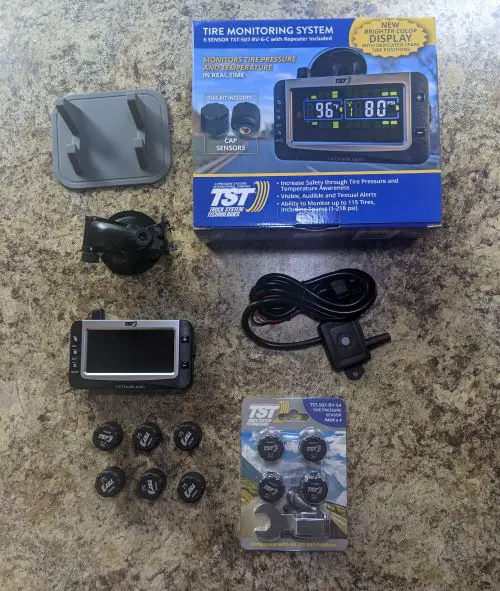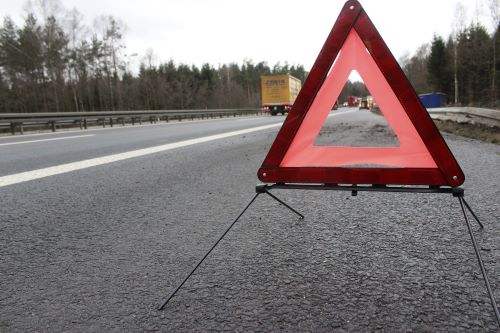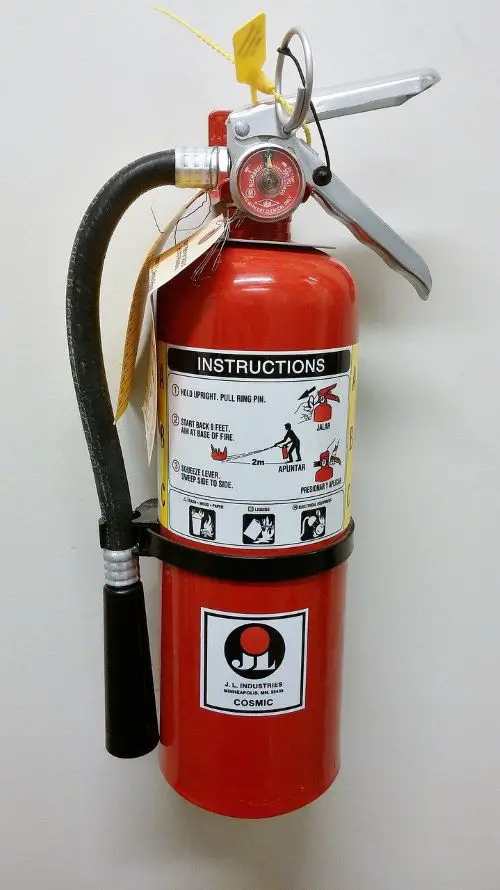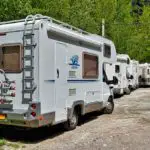RVing might seem like all fun and games (and often, it is!) However, there are also serious safety concerns you can run into if you’re not prepared. Having all the RV safety equipment you need could prevent serious damage to property or even your life. Luckily, by taking some simple steps you can reduce the “fear factor” of RVing and have even more fun!
It’s definitely a drag to spend even more money on your RV. They are already incredibly expensive to purchase and maintain as it is. However, the benefits of having the proper safety setup are worth it. Keep reading to find out what you might be missing.
RV Safety Equipment for the Rig
There are some upgrades you can do to your rig or tow vehicle to have a safer (and smoother) ride. Over time, Joel and I have begun adding the upgrades and the improvements are significant. Instead of white knuckle driving, travel is actually pleasant most of the time now.
Steering Stabilizer
A steering stable is something every motorhome owner should consider installing on their rig. Before our steering stabilizer, sudden gusts of wind or wobbly roads would be downright terrifying. Once, there was so much cross breeze that Joel’s arms were actually sore from having to manually compensate for all the side-to-side movement.
For a long time, we put off the purchase thinking all the RV bloggers were just trying to make a sale (plus they are expensive!) However, when we finally decided to give it a shot, it made a dramatic difference. I’m kind of mad we waited so long and put ourselves and others on the road at risk by going without. But live and learn, I guess. We are happy we have it now.
A steering stabilizer helps cut down on unwanted side-to-side movement. It makes things more predictable and reduces the fatigue you’ll have as a driver. You’ll need to do some research into what exactly your motorhome needs, but here is a link to some steering stabilizers to let you know what you’re looking for.

Sway Bar
For those with trailers, a sway bar is an add-on option to increase safety. You don’t have to have a sway bar, but when you do it can really help reduce the side-to-side movement of your trailer. The less your trailer moves side to side, the better for driving.
Other ways to reduce sway include proper loading techniques and slowing down. You can also improve your safety by traveling when the weather is cooperative as things like strong wind can increase sway.
Weight-Distribution Hitch
Another way to make your trailer safer on the road is by adding a weight-distribution hitch. If your truck bed sags down a lot when you attach your trailer, a weight-distribution hitch can help level the ride. It is important to note that this upgrade will not increase your vehicle’s towing or payload capacity.
Be sure to research specific hitches to make sure your choice will work with your trailer/tow vehicle before purchasing. If your truck bed is still sagging after installing a weight-distribution hitch, first check that you’re not over your vehicle’s payload capacity. Then, consider adding a helper spring or airbags.
Tire Pressure Monitoring System is a Critical Piece of RV Safety Equipment
It feels like every day we see another post about tire blowouts in the Cool RV Stuff Facebook group. Tire blowouts are scary and expensive, but they can also be life-threatening. One of the best pieces of RV safety equipment you can buy is a Tire Pressure Monitoring System (TPMS).
A TPMS gives you real-time data regarding tire health including tire pressure, temperature, whether you have a leak, and more. When you travel long distances and in all kinds of weather, you’re more likely to have problems. A TPMS can alert you to issues so you can intervene before it is too late.

EMS Surge Protector
We’ve got an entire article about why you need an EMS for your RV surge protector. If you want more information, check that article out. However, to summarize, EMS stands for “electrical management system”. It doesn’t just protect your RV from power surges but also from things like low voltage.
Low voltage can cause significant damage by causing appliances to overheat. Overheating can cause electrical fires that can easily destroy an RV. One of the simplest and most effective ways to protect yourself from RV fires (besides RV maintenance) is to use an EMS.
RV Safety Equipment for During Travel
While you are on the road, there are some other RV safety equipment items that are worth considering. With how often and how far we travel as RVers, we have a higher risk of getting in an accident or a hairy situation. Here are some items that can help mitigate your risk.
RV GPS
Have you ever ended up on a road you really shouldn’t have been on in your RV? I know we have and it is not something I would care to repeat. Using an RV-specific GPS or an RV road trip planning tool like RV Trip Wizard allows you to find roads that are safe for your specific rig.
Using RV Trip Wizard, you can enter custom specifications like weight, height, and length. The program then provides routing information to give you a safe drive every time. Most RV GPS options on the market offer similar features.
Dash Camera as RV Safety Equipment
Unless a witness stops to give a report to police, accidents sometimes end up being “he said she said”. If you use a dash camera, you’ll have video proof if someone else was at fault in an accident. It won’t protect you in the moment but it could protect you from costly repairs or litigation after the fact.
Backup Camera
Parking a trailer is no easy feat. I have seen more than one picnic table get rammed into this summer. If you don’t want a backup camera, working with a partner to direct you in is a definite option. For solo RVers or people who have a less than a reliable backup partner, a backup camera is an excellent purchase to add. You can make sure you don’t run over anything (or God forbid, anyone) while getting situated.
RV Safety Equipment You Need in Case You Break Down
Saying you need RV safety equipment in case you break down is truly optimistic Realistically, you’re almost guaranteed to break down at some point if you RV for any length of time. So when you do, here’s what you’ll want to have to keep you safe.
Emergency Traffic Triangles
When your RV breaks down, it is almost certainly not going to break down somewhere convenient. Even if you aren’t on a busy road, setting up some traffic triangles is a good idea. It warns oncoming motorists to slow down which keeps everyone safer.

Safety Vest
Construction workers don’t wear safety vests for no reason. Having a bright, reflective safety vest makes it easier for others to see you. If you are walking around outside your rig trying to diagnose the problem or change a flat, you should be cautious so you don’t get hit by a car. While far from stylish, a safety vest will help protect you on the road.
Flashlight or Headlamp
Having a flashlight or headlamp is helpful if you find yourself stranded at night. Even during the day a bright light can come in handy when looking under the RV. A headlamp is a fantastic choice because it leaves your hands free to work on repairs.
Basic Tools
Everyone should have some basic tools when they travel. The second you leave home without them is when you’ll run into problems. The bare minimum should include a number 2 Philips Head screwdriver, flathead screwdriver, needle-nose pliers, regular pliers, and two crescent wrenches. For changing a tire you need at least a lug wrench and a jack suitable for your RV. It would be best to have a full socket set. Ideally, you should have a tool for every fastener on your rig. Having a tire pressure gauge is also worth mentioning.
RV Safety Equipment for Inside
There is some basic RV safety equipment that you should have just like you do for your home. After all, even if you just adventure on the weekends, you’re still living in your RV. Here’s what you need to protect your rig and yourself.
Fire Extinguishers are a Must-Have for RV Safety
One of the best ways to make your RV safer and practice RV fire prevention is to carry several fire extinguishers. The ones that came with your RV likely aren’t going to cut it. They are too small to put out anything but the smallest fires. Some RVers have even reported these extinguishers didn’t work when needed.
I would recommend upgrading to a larger fire extinguisher and having one in the front, one in the bedroom, and one somewhere outside the rig that you can get to quickly. Joel and I have the 4-pound size and I would recommend getting one at least this big.

Fire Extinguisher Balls
In addition to a fire extinguisher, we also installed several fire extinguisher balls. These balls have a fuse that, when ignited, will basically cause the ball to explode an extinguishing powder. The fantastic thing about these balls is that they work to extinguish fires even when you’re not around.
They are pricey but the peace of mind is worth it in my opinion. We have one by the engine, one where all our electrical wires meet the circuit board, and one by the water heater. There are several brands of fire extinguisher balls, but the ones that have been proven to work most effectively (and the ones Joel and I use) are the Elide Fire Extinguishing Balls.
Fire Blankets
Some types of fires, like grease fires, aren’t as effectively extinguished with all types of fire extinguishers. Fire blankets can come in handy in this situation. Another benefit of fire blankets is that they don’t expire as fire extinguishers do.
You can also use a fire blanket as a last resort if you need to escape through the flames. You can wrap it around you and make a run for it. Make sure your fire blankets are easily accessible such as by your bed.
Propane/LP Gas Detector
Chances are your RV already has a propane detector. However, it is important to make sure it is working properly. To test it you can open your propane valve and close the windows for a couple of hours. If the detector goes off, you may have a propane leak and should get things inspected by a professional. The smell of rotten eggs in your camper is another tell-tale sign.
Smoke Detector/Carbon Monoxide Detector
Having a smoke detector and carbon monoxide detector should go without saying. Smoke and carbon monoxide can have even deadlier consequences in a small, flammable, enclosed space like an RV. Don’t forget to check the batteries on a regular basis.
Security Camera
Although most RV parks are relatively safe, it never hurts to add a layer of security to your home on wheels. Some RVers feel more comfortable installing a security camera on the inside or outside of their RV. As an added bonus, you can use an indoor security camera to monitor your pets while RVing if you have to leave them for a little while.
First Aid Kit
From scrapes to more serious injuries, a first aid kit can be a critical piece of RV safety equipment to bring along. Having the basics is important. If your family is accident-prone, you might want to add some additional gear.



